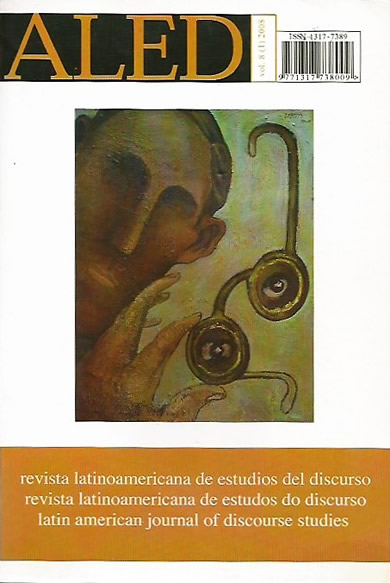El discurso multimodal en YouTube
Keywords:
critical discourse analysis. multimodality. poverty. YouTube.Abstract
This paper gathers the first reflections of the ongoing investigation “Critical Discourse Analysis in the Integral Study of the Text: understanding discourse of mass-media,” which is part of the networks PROSUL, REDLAD and PRO.TEX.TO. Firstly, it is proposed to contribute to reflections that for several years have been carried out on the media, critical analysis of the discourse on poverty and building a theory of discourse increasingly comprehensive and multidisciplinary. This study addresses the relationship between the media and multimodal discourse, typical of the mass media, mediated by information technology. This section intends to recognize the role in the construction of the meaning that derives from fixed multiple codes, to make them circulate as specific content on Websites. In addtion, the purpose of this paper is to unravel the role of the media and multimodality in the construction of meanings and, consequently, of social knowledge. Secondly, it addresses the YouTube discourse about poverty, to define the categories of analysis that come from theoretical reflections of Kress and van Leeuwen (1996), van Leeuwen and Jewitt (2001), and van Leeuwen (2008) that make possible formulation of an analytical perspective from a particular corpus. Finally, we present an outline to guide the methodology; for this purpose we reviewed some categories and principles in the perspective of O’Halloran (2006). This enables to make Critical Discourse Analysis of poverty in YouTube, for it is applied in a specific case. This exploratory analysis is applied to the video “La rutina” http://es.YouTube.com/watch?v=BF8HZTGzz28, which is part of the corpus of this investigation.
Downloads
References
BAJTÃN. M. (1985). Estética de la creación verbal. México: Siglo XXI.
BREA, J. L. (2002). El arte del futuro. En: http://www.nettime.orgCASTELLS, M. (2003). A era da informação: economia, sociedade e cultura. Lisboa: Fundaçao Calouste Gulbekian.
EKMAN, P. & FRIESEN, W. (1969). ‘The repertoire of nonverbal behavior: Catego-ries, origins, usage, and coding’, Semiotica, 1: 49- 98.
JEWITT, C., VAN LEEUWEN, T. (2001). Handbook of visual analysis. London: SagePublications.
KALTENBACHER, M. (2004). ‘Perspectives on Multimodality: From the early beginnings to the state of the art’,en: Information Design Journal, 12 (3):190-207(18). Amsterdam: John Benjamins Publishing Company.
KENDON, A. (1983). ‘Gesture and Speech: How They Interact’, en J. M. Wie-mann & R. P. Harrison Nonverbal Interaction, pp. 13-43. Beverly Hills:Sage Publications.
KRESS, G., VAN LEEUWEN, T. (1996). Reading images. London: Routledge.
KRESS, G., VAN LEEUWEN, T. (2001). Multimodal Discourse: The Modes and Me-dia of Contemporary. New York: Hodder Arnold.
LEVY, P. (2000). Las tecnologías de la inteligencia. El futuro del pensamiento en laera informática. Buenos Aires: Edicial.
MANOVICH, L. (2008). ‘The practice of everyday (media) life’, en http://www.manovich.net/.O’Halloran, K. (2006). Multimodal Discourse Analysis: Systemic Functional Pers-pectivas. Londres: Continuum.
PARDO ABRIL, N. (2007). Cómo hacer análisis crítico del discurso. Una perspectivalatinoamericana. Santiago de Chile: Frasis.
RIFKIN, J. (1997). El fin del trabajo. El declive de la fuerza del trabajo global y elnacimiento de la era posmercado. Madrid: Círculo de lectores.
VAN DIJK, T. (en prensa). Discourse and Context. Cambridge: Cambridge Uni-versity Press.
VAN LEUWEEN, T. (2008). Discourse and Practice. New Tools for Critical DiscourseAnalysis. Oxford: Oxford University Press.
Downloads
Published
How to Cite
Issue
Section
License

This work is licensed under a Creative Commons Attribution-NonCommercial-NoDerivatives 4.0 International License.
The authors retain the copyright and guarantee RALED the right to be the first publication of the work as well as a Creative Commons Attribution License that allows others to share the work with recognition of authorship and the initial publication in this journal.




